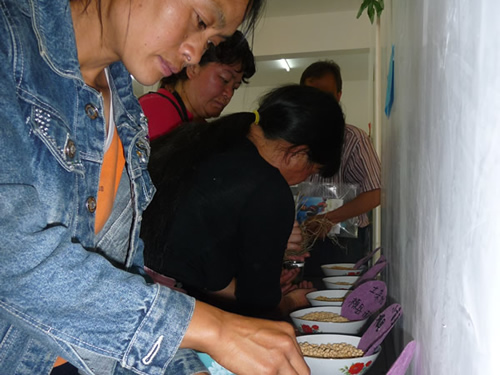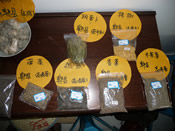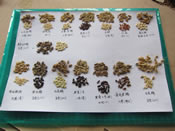
 |
| PCD supports farmers to grow traditional crops and organises an exchange activity on seeds, in which farmers from Yunnan, Guizhou, Sichuan and Guangxi gather to introduce their traditional crops seeds and exchange on knowledge of growing these crops. (Angus Lam/PCD) |
By May Tam (Communications Officer, PCD)
Since the rise of modern agriculture, many farmers have been replacing traditional local crop varieties with a smaller number of newly developed or foreign ones, and have adopted the practice of monocropping on a large scale. The result has been a diminishing of crop diversity. Conserving traditional crop varieties is, therefore, an important issue in ecological agriculture. Preserving crop genetic resources enhances the biodiversity of farmland and guarantees food security, and thus it is an important condition for the emergence and development of sustainable agriculture.
Agricultural biodiversity contributes to the diversity of the ecosystem and can increase agricultural output, guarantee production stability and enhance ecosystem functions. It is also environment-friendly. It improves the adaptability of crops and the resilience of the agricultural system, as well as reducing risks of changes in environmental conditions, crop failures, market fluctuations, and attacks of pests and diseases.
Massive loss of food crop diversity
However, development of modern agriculture has diminished traditional crop varieties and diversity in agriculture — a global phenomenon and a major crisis. The Food and Agriculture Organisation of the United Nations estimates that 75% of food crop diversity was lost between 1900 and 2000. In China, due to the development of biotechnology and monocropping, traditional crop varieties are disappearing at a rate of 15% per annum, resulting in a massive loss of genetic diversity. To guarantee food security for China’s 1.3 billion population and to improve the quality of life and standard of living in China, it is necessary to conserve and utilise crop genetic resources, which means conserving traditional crop varieties.
Apart from increasing the volume of agricultural output and improving output stability, a diverse food supply also improves people’s nutrition and health. A number of studies have shown that, compared with a simple ecological system, a diverse ecological system is more productive. In China, a study done by F. Zhang and L. Li which was released in 2003 found that wheat shows a 74% yield increase when intercropped with maize and a 53% increase when intercropped with soybean. Studies have also found that intercropping improves crops’ absorption of nutrients. For example, peanut plants often turn yellow and wilt because of iron deficiency. The problem is alleviated by intercropping peanut and maize, probably because of the capacity of maize to absorb iron, which helps peanuts to make better use of iron in the process. Crop diversity also reduces the problem of harvest failure because when one crop fails, there are still other varieties of crops that may have survived. Many studies have also found that crop diversity reduces pest and disease damage and, to a certain extent, guarantees crop output, minimising the risk of complete crop failure.
For the reasons mentioned above, we advocate conservation of local crop varieties and the revival of agricultural biodiversity and the awareness of its importance.
The crisis of modern agriculture
In an ecological environment with high biodiversity, new species of animals and plants may develop that are better adapted to changes in the natural environment. This in turn helps to alleviate the problems brought by climate change. Likewise, when agricultural biodiversity is high, the impact of climate change is likely to be reduced. An example is Mali in Africa. The country grows various traditional varieties of sorghum. Despite suffering from two decades of drought, the output of sorghum and productivity of the country between 1978 and 1998 remained stable.
When a foreign crop is introduced, the focus is often on increasing production output while its adaptability to the local natural environment is ignored. Chemical fertilisers and pesticides are usually applied in large quantities to ensure a high yield, resulting in severe damage to the farmland ecology. In addition, farmers have to pay for seeds. As they become dependent on external provision of seeds and less self-reliant, they are faced with the problem of seed security. In other words, modern agriculture has changed the role of farmers—guardians of the seeds that are the source of our food—by forcing them to abandon the traditional farming practice of selecting crop varieties adapted to the local environment. Reversing this logic of nature has resulted in the present agricultural crisis.
Conserving traditional varieties and reviving vitality of farmland
Since traditional crop varieties have been selected and cultivated by local farmers over generations, they are usually well adapted to local environmental conditions. The production output of traditional crop varieties is rather stable and they are highly risk-resilient. They are also less dependent on external inputs. Moreover, traditional crop varieties meet local tastes and food preferences and are also connected with local culture and traditional customs.
In traditional cultures, farmers consider seeds as living things that have souls. Industrialised agriculture has successfully changed this idea and has turned seeds into agricultural resources that are no different from a screw or other assets in mechanical and factory production. Genetically modified crops developed over the last few decades have gone to the extreme in turning seeds into something non-natural and lifeless. Conserving traditional crop varieties is, therefore, a way to enable the farmland to again manifest its fertile vitality.





